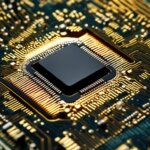Table of Contents
Semiconductors are an essential part of modern technology and electronics. They have revolutionized the way we live, work, and communicate. From smartphones to computers, from cars to airplanes, semiconductors are found in almost every device and gadget that we use today.
So, what is a semiconductor? It is a type of material that has an electrical conductivity between that of a conductor and an insulator. It means that semiconductors can both conduct and block electrical current. This unique property makes semiconductors ideal for controlling the flow of electricity.
The discovery and development of semiconductors have had a significant impact on the world. It has enabled the creation of fast, efficient, and reliable electronic devices that have transformed industries and economies. In this guide, we will explore the basics of semiconductors and their role in electronics.
Key Takeaways
- Semiconductors bridge the gap between conductors and insulators in terms of electrical conductivity.
- Semiconductors are essential for controlling the flow of electricity in electronic devices.
- The unique properties of semiconductors have enabled the development of fast, efficient, and reliable electronic devices.
- Semiconductors play a crucial role in modern technology and are found in almost every device and gadget.
- The discovery and development of semiconductors have transformed industries and economies.
What is a Semiconductor?
In the world of electronics, semiconductors play a pivotal role in powering modern technology. But what exactly is a semiconductor? A semiconductor is a material whose conductive properties sit between those of conductive and insulating materials, which gives it unique electrical characteristics. To understand semiconductors better, let us delve into their fundamental properties.
Valence Electrons and Energy Levels
The key to semiconductors’ unique properties is how their valence electrons occupy their energy levels. Valence electrons are the outermost electrons of an atom that determine how the atom bonds with other atoms. Semiconductors, made from elements like silicon and germanium, have four valence electrons. These electrons are located in a stable energy level, making it hard for them to move and conduct current.
However, when a semiconductor is exposed to energy, such as heat or electricity, the energy can cause electrons to move from the stable energy level into a higher energy level. This process is called “exciting” the electrons. The energy level with the excited electrons is now an “active” energy level with free electrons that can conduct an electrical charge.
Conduction Capabilities
The conduction capabilities of a semiconductor depend on its energy level and the number of free electrons available for conduction. If the energy level is low, there won’t be many free electrons to conduct, resulting in poor conduction. If the energy level is high, and there are numerous free electrons, then the semiconductor can conduct electrical charge effectively.
By altering the doping process, where impurities are added deliberately to semiconductor crystals, it is possible to “fine-tune” the number of free electrons in the active energy level, resulting in enhanced conduction capabilities. Using doping with boron or gallium impurities results in “p-type” semiconductors, while phosphorus or arsenic doping results in “n-type” semiconductors.
Differences Between Conductive and Insulating Materials
To understand the unique properties of semiconductors, it’s essential to differentiate them from conductive and insulating materials. Conductive materials, such as metals, have a large number of free electrons and can conduct electrical charges effectively because they have low resistance. Conversely, insulating materials, such as rubber, have few free electrons and high resistance to electrical charges.
The Role of Semiconductors in Electronics
Semiconductors play a crucial part in the creation of modern electronics. They are used to develop important electronic components such as diodes, transistors, and integrated circuits. To understand how these components work, it is helpful to know some of the basics concerning semiconductors.
Semiconductors are materials that have a middle-ground electrical conductivity that falls between insulators and conductors. The electrical conductivity of semiconductors can be changed and controlled by adding impurities to the materials, a process which is known as “doping”. Furthermore, semiconductors exhibit different energy levels, meaning they can be used to create artificially induced p-n junctions that form the basis of many electronic devices. Diodes and transistors, for example, rely on p-n junctions to function effectively.
Diodes are two-terminal electronic components consisting of a p-n junction that allows current to flow in only one direction. Diodes are commonly used in electronic circuits and have many applications in electronic devices such as power rectifiers, voltage regulators, and oscillators.
Transistors, on the other hand, are three-terminal electronic components that can amplify or switch electronic signals and power. A transistor consists of a semiconductor material that is doped with impurities to form two p-n junctions, which work in conjunction with an attached control terminal to amplify or switch electronic signals.
Integrated circuits, or ICs, are miniaturized electronic circuits that typically consist of multiple transistors, diodes, and resistors (amongst other components) in one, small package. The invention of integrated circuits has transformed the world of electronics, allowing for smaller, more powerful, and more complex electronic devices than ever before.
“Semiconductors have impacted virtually every aspect of modern life, from the household appliances we use to the smartphones we rely on for communication. We owe much of our technological progress to the ability of semiconductors to transform the field of electronics and create smaller, more powerful electronic devices.”
Conclusion
In conclusion, this comprehensive guide has provided an essential understanding of semiconductors. We have learned what semiconductors are, their properties, and their significance in the world of electronics. Semiconductors are essential to the functionality and advancement of modern technology. From diodes to transistors and integrated circuits, semiconductors have revolutionized the electronics industry and impacted various industries such as telecommunications, healthcare, and finance.
As technology continues to evolve, semiconductors will play an even more significant role in the future. Advancements in nanotechnology and the development of new materials will enhance the capabilities and efficiency of semiconductors. Thus, it is crucial to continue researching and developing new ways to improve the performance of semiconductors.
The understanding of semiconductors and their role in modern technology has become increasingly relevant and necessary for both professionals and enthusiasts alike. With this knowledge, we can appreciate the immense contributions of semiconductors to society, and look forward to the exciting possibilities that lie ahead.
FAQ
What is a semiconductor?
A semiconductor is a material that has the ability to conduct electricity, but to a lesser extent than conductive materials. It falls between conductors, which freely allow the flow of electrical current, and insulators, which block the flow of current. Semiconductors have unique properties that make them essential in modern technology.
How do semiconductors differ from conductive or insulating materials?
Semiconductors differ from conductive materials in that their electrical conductivity is intermediate. While conductive materials allow free flow of electrical current, semiconductors possess a conductivity range that can be manipulated by applying external influences such as temperature or voltage. Insulating materials, on the other hand, have minimal conductivity and impede the flow of electrical current.
What is the role of valence electrons and energy levels in semiconductors?
Valence electrons are outermost electrons in an atom that are involved in chemical bonding. In semiconductors, their behavior is crucial for conducting electricity. The movement of valence electrons between energy levels determines the conductivity of semiconductors. By manipulating the energy levels, it is possible to control the flow of current, allowing semiconductors to function as switches or amplifiers.
How do semiconductors contribute to electronics?
Semiconductors play a vital role in the field of electronics. They are used in the creation of essential components such as diodes, transistors, and integrated circuits. Diodes allow current to flow in one direction, transistors amplify or switch electronic signals, and integrated circuits combine multiple functionalities into a single chip. These components are the building blocks of various electronic devices, enabling the functionality and advancement of technology in industries like telecommunications, computing, and consumer electronics.
What is the significance of semiconductors in modern technology?
Semiconductors are the foundation of modern technology. They have revolutionized industries such as telecommunications, computing, renewable energy, and healthcare. The ability to manipulate the flow of electrical current with semiconductors has led to the development of faster and more efficient electronic devices. Additionally, semiconductors have paved the way for innovations in areas like artificial intelligence, Internet of Things, and autonomous vehicles.
How are semiconductors impacting various industries?
Semiconductors have had a profound impact on various industries. In telecommunications, they are instrumental in the development of faster and more reliable communication networks. In computing, semiconductors have enabled the creation of powerful processors and memory devices. In renewable energy, semiconductors are a core component of solar cells, which convert sunlight into electricity. In healthcare, semiconductors are used in medical imaging devices and implantable medical devices. Overall, semiconductors have opened up new possibilities and advancements in numerous sectors, enhancing our daily lives and pushing the boundaries of technological innovation.











